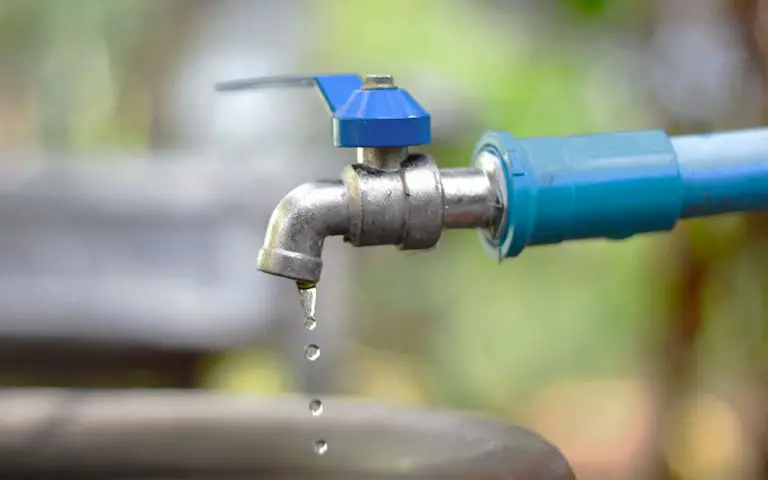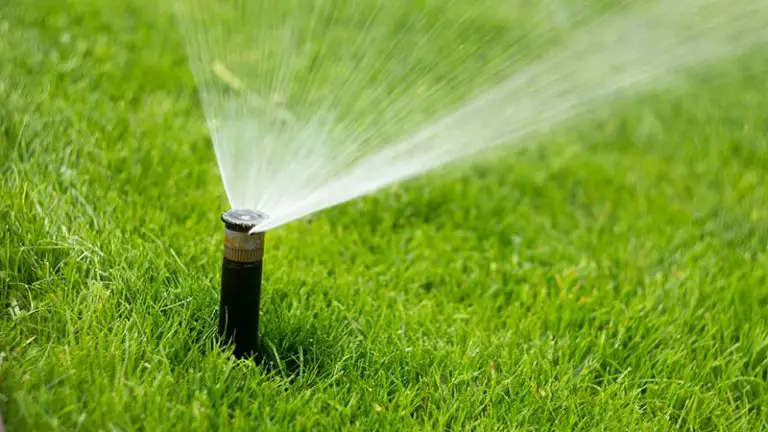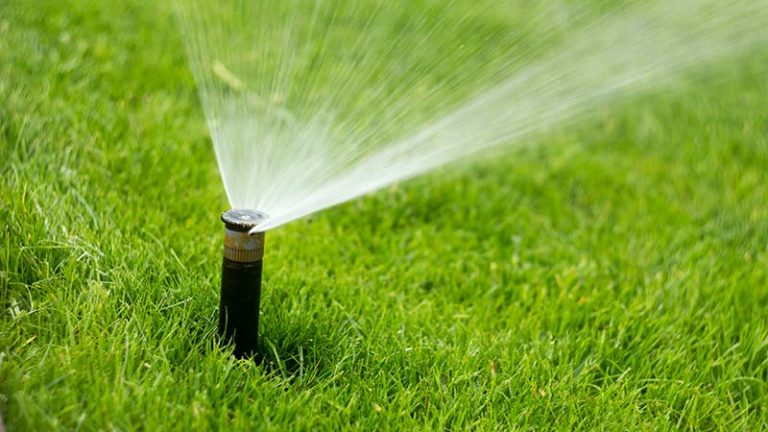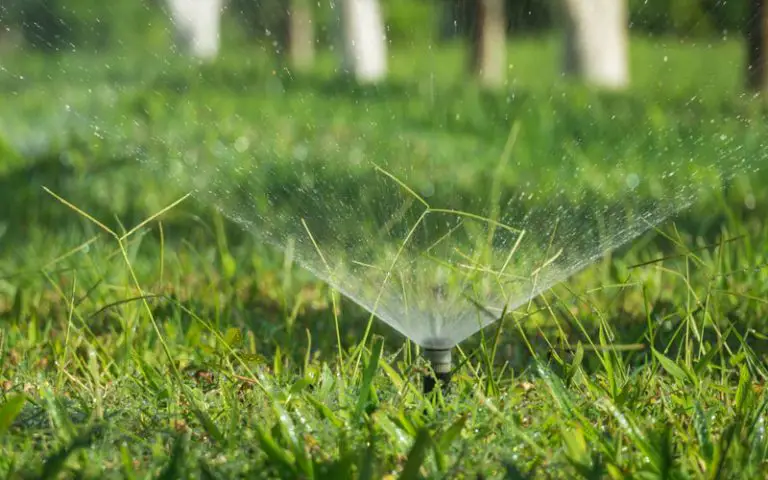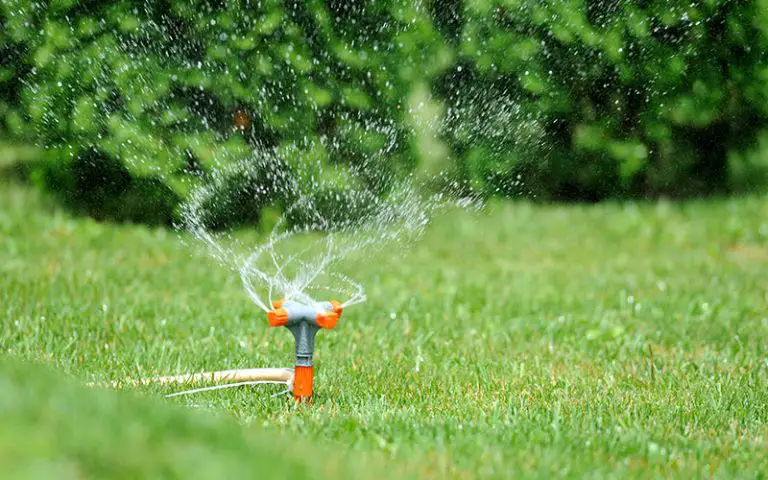How to Get Rid of Standing Water in Yard
Standing water can easily become a nuisance when left in your garden for a period of time. It can attract bugs, damage your yard, create smells and be generally unsightly.
If you have standing water in your yard, it’s best to remove it as soon as possible.
There are many causes of standing water, but it’s commonly caused by dips in the land or other structures that allow water to congregate. Standing water can be removed and prevented in a variety of ways, depending on its causes. Standing water can be removed by fixing damaged pipes, waiting for it to evaporate or by physically removing it with buckets amongst other things, depending on what the source of the water is.
What is Standing Water?
Standing water refers to an unmoving puddle of water that doesn’t flow or isn’t able to drain. Its lack of movement leads to it becoming stagnant, dirty and smelly. Any standing water left outside has the potential to become stagnant water, no matter how much of it there is. This can mean that a bucket of water sat under the porch could be considered standing water, along with larger masses of water such as unemptied pools or large puddles in the front lawn.
Standing water can come from a variety of sources, and can come from clean sources. A lot of stagnant backyard water comes from burst or damaged water pipes. Even though standing water may begin clean, it can very quickly and easily turn- leading to it becoming an even bigger problem.
What Causes Standing Water?
Standing water can be caused by any source of water, providing there isn’t an adequate means of it moving or draining by itself. Some of the more common causes of standing water are drain breakage or damage causing a yard to flood, rain water becoming trapped in the yard and being unable to drain, leaving pools undrained, birdbaths, or any contained water that is out in the open and unable to drain.
If your yard frequently has standing water, it could be due to the terrain being uneven or depressions in the ground which could assist in collecting water, similarly to a bowl. In addition to this, any object or equipment has the potential to create standing water providing it is capable of holding water. This includes things such as wheelbarrows, birdbaths, water bowls, other debris or any other items that can collect water. Standing water can be a problem both inside and outside the home.
What are the Dangers of Standing Water?
Standing water can become an issue fairly quickly depending on its size and location. Whilst standing water may not appear to be an issue at first, it can very easily become one. The main concerns with standing water are the damage it can cause, and the mosquitoes it can attract.
Standing water has the potential to damage its surroundings, depending on where it’s located. For example, most basement leaks are caused by standing water being present around the foundations of the home. Come winter, this standing water freezes, expands, and as a result damages the house’s foundation, leading to leaks. Standing water in the garden can be particularly unappealing, as it can cause discoloration of grass, damage to grass and other plants, and even damage to underground systems such as irrigation systems.
Along with being unsightly and damaging to its surroundings, standing water is also the chosen breeding ground for mosquitoes and other pests, regardless of how much standing water there is or where it’s located. Mosquitoes have the potential to carry diseases such as zika, malaria and west nile. It’s important to keep mosquitoes at bay wherever possible, meaning that removing standing water before mosquitoes begin to find it should be a priority.
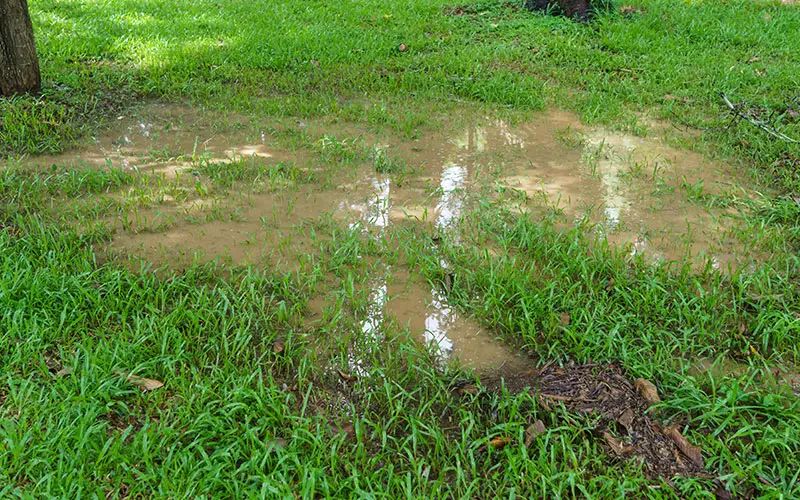
How to Tell if you Have Standing Water in your Yard
Standing water isn’t always apparent in your yard. Whilst it’s hard to ignore large patches of grass being covered by standing water, it isn’t always easy to find standing water when it isn’t as obvious.
Standing water in your yard can begin to pool in different sizes and areas. The best way to see if your yard has standing water in it is to check via process of elimination. Identifying the places where stagnant water is likely to sit is vital to checking whether or not your yard has any standing water hiding away somewhere. Stagnant water, if not on the grass or any other parts of the lawn, is likely to be caught up in places that entrap water, such as watering cans, wheelbarrows, birdbaths or other vessels that have no immediate draining solutions.
Whilst physically looking for the standing water is the best way to be sure it’s there, there are other signs to look out for which may suggest that standing water may be to blame.
Mosquitoes
An increase in mosquitoes around your property and garden may suggest that there is standing water somewhere in the vicinity that they are using as a breeding ground. Noticing that there are more mosquitoes than usual in the area should be an indication that there is something amiss with the amount of water in the area.
Dragonflies
Dragonflies are a lot more welcome than mosquitoes as they don’t carry the same risk that they do. However, like mosquitoes, dragonflies also breed over standing water. An increase in dragonfly activity can suggest that there is a surplus of standing water in the area.
Muddy Areas
Mud is expected after any rainfall, but if you consistently find areas that are muddy, despite other areas drying up as normal, it could be a sign that water isn’t draining or going away from certain places in your yard.
Small Floods
Small floods that appear during heavy rainfall can be a sign that your water isn’t draining as it should and that it could become a larger issue in the future. If unable to evaporate or drain fully, this could easily turn into standing water.
Ill Pets
If any pets or animals live with you, their health can be a sign of whether there is standing water nearby. Standing water is often the host of parasites such as ringworm and other microbes that can make your pets and animals ill. If you have a dog or other animal that has recently been infected with ringworm or some other waterborne parasite, it’s important to ensure that it hasn’t come from standing water nearby.
Getting Rid of Standing Water
The removal method for standing water changes depending on what the cause of the standing water is. Once the source has been identified, it’s simply a matter of removing the standing water and preventing it from occurring again. The solution may be a long term one or a short term one dispensing on the severity of the standing water and the way in which the standing water is being collected.
Removing Standing Water from Lawn Equipment
Lawn equipment such as watering cans and wheelbarrows are very likely to collect and retain water that will eventually turn stagnant. This equipment isn’t often used every day so it’s easy for water to remain trapped for what could become months depending on how often the equipment is used.
Cleaning this equipment up is fast, easy, and it’s also very easy to prevent water buildup again in the future.
To displost of the standing water, tip it down an outside drain and then use rags, towels or another absorbent material to clean the excess water from the equipment. Making sure it is dry will reduce the risk of rust or any other water damage that may occur.
Once the water is removed and dried from the equipment, make sure that it is stored in a way to prevent water from stagnating on it again. This could mean putting it in a shed or underneath some other outdoor cover, or in the case of a wheelbarrow, simply turning it over so water can’t collect inside.
It should also be noted that equipment covered with tarpaulin also has the risk of leading to standing water, as tarpaulin can be notorious for collecting water. Luckily, it often evaporates before it becomes an issue.
Removing Standing Water from a Birdbath
Birdbaths can easily become stagnant and can produce some pretty nasty smells. It could make you wonder why any animal would want to bathe in it. Depending on the birdbath and how shallow it is, the water can evaporate fairly quickly, avoiding water from going stagnant. However, most birdbaths will retain just enough water to begin to smell after some time. The best way to avoid this is simply by swapping the water out whenever possible. Ideally, once a week should prevent any bad smells or dirty water. To clear a birdbath out, use a cup or other small object that will hold water and use it to scoop the dirty water out and dispose of it properly. Tipping the whole birdbath may be quite hard depending on the actual structure and size of it, so emptying it using a cup is the next best thing. Once the bath is empty, give it a slight rinse and clean using a paper towel or reusable towel, and then refill it up.
Whilst regularly changing your birdbath’s water is a good way to reduce the risk of water going stagnant, it can be easily forgotten or overshadowed by other chores. If you don’t have the time to change a birdbath’s water frequently and don’t want to deal with any standing water that may come of it, there are other ways you can invite birds into your garden that will not result in any standing or stagnant water.
- Bird feeders – Bird feeders are easy to buy, easy to set up and can be refilled on your own basis. Whilst they might invite squirrels or some other pests, they won’t come with the associated risks of standing water.
- Bird houses – Bird houses are aesthetically pleasing and very little maintenance is needed once they’re set up.
Removing Standing Water from Uneven Lawn
Finding pools and puddles in your garden can suggest that there is an issue relating to drainage or the turf which can lead to standing water. Standing water can be dangerous, due to reasons discussed previously, and needs to be removed and prevented as much as possible.
If the standing water is affecting your lawn and yard, it may be a more difficult fix than if it were affecting gardening equipment and furniture.
Standing water on the lawn can be caused by drainage issues, either due a damaged pipe beneath the ground or because there is no way for the rainwater to go once it has landed on the lawn. It can also be a sign that there are issues with a drain beneath the lawn, such as a burst pipe in an irrigation system or a faulty sewer line.
The first thing to do if you suspect that you have standing water in your garden is to investigate the possible cause of it.
If you believe that the issues pertaining to your lawn are not caused by a faulty pipe or drainage, there are a couple of different causes that could be at play.
- Soil – Certain soil types may make water drainage more difficult. For example, soil that is high in clay is unlikely to drain water as effectively as loamy soil.
- Heavy rainfall – The event of heavy rainfall will see many gardens that don’t usually flood with excess water. If you find that even in some milder rainfall, specific areas of your lawn become puddled, it may be a sign that the lawn dips or something in that area is preventing water from draining.
- Low Spots – Low spots in the garden can lead to more rainwater pooling after a bout of bad weather. This can be due the garden being pooly levelled or the climate as a whole.
- Lawn thatching – Lawn thatching refers to the way in which the grass is planted in order to aerate the soil beneath it. Poorly aerated soil is more likely to result in puddles and pools in the gardens.
Removing standing water from the yard is often a game of waiting for it to evaporate. Of course, some added precautions can be taken to help it dry up quicker, such as removing as much as possible using buckets or cups.
Fixing Issues in your Yard That Cause Standing Water
Once you’ve investigated and diagnosed the issue that is causing standing water in your yard, you can begin to think of possible solutions or ways to alleviate the issue. Depending on the cause of the standing water in your yard, the resolution could be either straightforward or require landscaping. Always make sure to assess the impact that the standing water is having on your yard and home before deciding to fix the issue, as it could lead to expenses and invasive treatment which may not be worth the hassle.
Soil
The type of soil that is in your yard can make a massive difference to your yard’s ability to drain water. Some types of soil are more likely to have higher clay content than others, and these types of soils are to be avoided if you want better drainage in your yard. Soil that is high in clay is oftentimes more compact and harder for water to pass through. In the event that your lawn soil has a high clay content, the best thing to do is to mix it up a bit with another type of soil which is high in loam instead. You can do this by resurfacing your lawn with a more loamy soil and replanting the garden using flats of grass.
Heavy Rainfall
Whilst there’s no way to prevent heavy rainfall, there are ways you can prepare your lawn for it. Focusing mostly on ways you can drain water from the yard is the most effective way of preventing or avoiding large puddles from forming and becoming stagnant. One of the ways this can be achieved is by adding drainage ramps to the yard for water to flow down rather than getting caught in the grass. Areas that often suffer from heavy rainfall are likely to already have these types of ramps installed. Replacing the soil may also help in this case, as water is more likely to be backed up if your soil is high in clay content.
Perhaps a last-ditch effort, planting more trees and/or shrubs can help reduce the likeliness of standing water making its home in your yard, as rooted plants are able to absorb more water than the grass alone will.
Low Spots
Low spots in your yard can be more difficult to fix, depending on the severity of them and the general landscape. For instance, a pit or other deep drop may require a professional landscaper’s opinion or need to be filled in, whilst a low spot between two hills may benefit from something like a French drain, which is fairly easily installed. If low spots are your main concern, the advice from a landscaper would be more beneficial than simply attempting to fix the issue yourself.
Lawn Thatching
Your lawn’s thatching refers to the way in which your grass grows and how orderly it does so. The way in which your grass grows can affect your lawn’s aeration, as grass can have the tendency to knot and entwine just beneath the surface. This can make drainage an issue, as the knotting grass can become dense and hard for water to pass through. If you presume that this is the issue affecting your lawn, there are some fairly simple ways to go about fixing it. Breaking up the grass below the surface using a hoe, aerator or an unthatcher is ideal, as it creates space for water to pass through beneath the surface. Most effective is the dethatching blade that can be easily attached to a lawnmower and run over areas that require aeration each year.
- Replacement deluxe dethatching blade
- Fits MOST (Not all) walk-behind mowers with a 21" and 22" deck cutting width
- For AYP/EHP/Sears/Craftsman, Bolens, Honda, Huskee, Husqvarna, Lawn-Boy, MTD, Murray, Poulan, Snapper, Toro, Troy-Bilt, Yard Machines and Yard-Man
- Dethatches, scalps, rakes, cuts, mulches and bags; Contains blade, hardware pack and dethatching line
- Center Hole Pattern 3/8", 7/16" & 5/8" universal center hole
Standing Water in Pools
Standing water in pools and ponds can easily become an issue. Whether or not your pool is outdoors, the water it contains can easily become stagnated and dirty if the pool isn’t maintained correctly. Regardless of whether you intend on using your pool or not, during times of unuse it needs to be cleared and cleaned to prevent any water from becoming stagnant or preventing any water from entering before it is to be used again. As the water within pools is cleaned and chlorinated, it prevents it from becoming stagnant and dirty despite the fact that it is unmoving. This water can quickly turn if the pool is left unmaintained or unused for a period of time. There are ways to properly drain your pool and protect it from water reentering.
Draining your Pool
When ceasing the use of your pool, make sure it is properly and fully drained. Leaving a pool partially drained of with large puddles in the bottom will lead to the water becoming stagnant, smelly and dirty. Any water has the potential to become standing water if left outside or uncovered, meaning that despite having previously been chlorinated, your pool’s water can turn too if left undrained or neglected.
Protecting your Pool
Once your pool has been fully drained and is dry inside, you can easily protect it from the rain or any other water from entering by putting a tight-fitting cover over it. These covers are usually made from either tarpaulin, polyethylene or vinyl, and prevent water from entering the pool once they’re secured over the top.
These covers can sometimes still allow water to pool on top of them, and can ironically be a source of stagnant water if left. In this case, all that you need to do is lift the pool cover and allow the water to roll off before reattaching it. Most pool covers nowadays are made of polyethylene or vinyl, and are therefore firmer and less likely to collect water.
Plumbing Problems
Standing water doesn’t always have to be caused by a landscaping or mismanagement issue. Sometimes it’s down to drains leaking or other plumbing problems that are affecting your yard. Oftentimes, these sorts of problems are only revealed by the standing water that they produce in the yard. They can be caused by a variety of different plumbing faults, such as broken lines or backed up lines forcing sewage back up into the system. These issues aren’t always caused by sewage lines, however, and could even be down to an issue with your irrigation system. Burst pipes are often caused by ice expanding as they freeze, due to failure to winterize a system correctly.
There are several ways you can tell if the standing water in your yard is caused by plumbing problems.
- Lawn being inexplicably wet – The lawn being inexplicably wet, despite having no rain or other reason to be wet, is a telltale sign that there is an issue beneath the lawn involving drainage or plumbing pipes. You should also be aware if only one part of the garden is wet, whilst the rest is dry.
- Basement floods – If you find your basement flooding more frequently than it should, it could be a sign that there is faulty plumbing afoot.
- There are plumbing issues inside the home – If you find that your sinks and bathtubs are taking longer to drain, or if you’ve experienced other drainage issues inside the home, it could be affecting your garden as well. You may be able to tell that a fault is affecting the lawn after experiencing some issues within the home.
- There is a smell – The smell of sewage and other drainage may linger over your lawn if the standing water’s source is that of a damaged plumbing pipe.
How to Fix Plumbing Problems
Unfortunately, if the issue stems from a drainage or sewer line pipe, the issue will most likely need to be resolved by a professional plumber. The fix will depend on the size of the pipe damage, and the location of the damage. If you suspect that the standing water in your yard could be caused by a damaged sewer line or pipe, make sure to get the issue addressed as soon as possible, lest the lawn become dirty and unhygienic.
How to Fix Irrigation Pipes
On the contrary, an issue with your sprinkler system can potentially be fixed without needing to bring in experts- depending on how confident you are and whether you have access to the materials and equipment needed. You can sometimes deduce where the leak is coming from based on the location of your sprinkler lines and the location of the puddle. Once you’re confident that the leak is located near a sprinkler line, turn off your water supply to the irrigation system and dig up that sprinkler zone to inspect the pipe. A partial or full pipe replacement may be needed to ensure that the leak is fixed. You can sometimes diagnose a leaking irrigation system based on the performance of your sprinklers. For instance, a system may not turn on if there is a faulty line, or the water pressure for your sprinkler system may inexplicably drop.
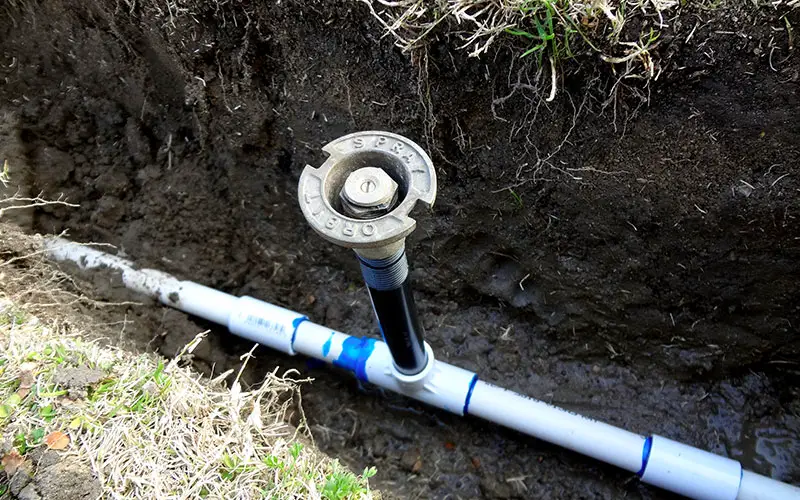
When Should I Call a Professional?
If there is an issue with your drains, a professional should be called as they may be the only ones able to fix the issue and gain whatever permissions are needed to undergo the task. Plumbing issues can easily begin to affect multiple homes or a whole street if left untreated, meaning that it’s important to call a professional right away if you suspect there is a problem with your drainage.
You should only attempt to fix the issue of standing water yourself if you know the cause of it and know how to fix it. Certain Homeowner Associations (HOAs) will take immediate action if standing water becomes an issue in your yard. Along with the risks to health and increase in mosquito and dragonfly activity, this makes it important to resolve the issue as quickly as possible.
Getting Rid of Mosquitoes
An increase in mosquitoes can act as a telling sign that there is standing water on your property. But once the water has been removed, how do you get rid of the mosquitoes?
Mosquitoes’ breeding activity will diminish once the standing water has been removed from the premises. They are notorious for using standing water as their breeding grounds, so removing it is the best way to slow down their reproduction. Whilst they may have stopped breeding, there will still be a surplus of mosquitoes on your property.
Mosquito Control
For the most dire circumstances, mosquito control experts can be called to exterminate the pests on your property. Whilst this may seem like an extreme step, if standing water has been on your property (or even worse, managed to get inside your property), mosquitoes will be well established both outside and inside the house.
Chemical Repellent
Chemical repellent is just what mosquito control experts use but on a smaller scale. Use this repellent lavishly, making sure that areas that you often find mosquitoes in are well protected.
Prevent Them From Coming Inside
You’re going to struggle to keep mosquitoes away from you whilst you’re outside- especially if that’s where your standing water once was. While you bide your time and wait for the bloodsucking vermin to die out or move on, you can protect the inside of your home by making sure any gaps or areas that mosquitoes can enter through are closed off, by utilizing mosquito traps, or by using mosquito nets.
Removing Mosquitoes from the Garden
Once the standing water has been removed, it may become a waiting game for mosquitoes to eventually move on or die off. There are, however, ways to reduce mosquito activity in the yard even after their breeding ground has been removed.
- Ensure no more standing water begins to form – This will mean that the mosquitoes won’t have an adequate place to breed.
- Use chemical repellents – Chemical repellents can be easily used outside as well as inside to reduce mosquito activity.
- Plant deterrents – Certain plants and shrubs are theorized to repel mosquitoes. These include lavender, tulsi, lemon balm, lemongrass, sage, basil and garlic.
- Use a bug zapper – Bug zappers can be hung outside to attract and kill insects. It’s actually not a particularly effective way of killing mosquitoes, however, as they aren’t attracted to the light as some other insects are. Instead, you rely on them following other insects towards the zapper. When using a bug zapper, you’re more likely to kill more harmless insects than mosquitoes.
- Thermacell – Thermacell containers are an insect repellent that are effective against mosquitoes. They’re no-mess and can easily be left outside to give your other insect repellents an added boost.
Final Thoughts
Standing water in your yard can quickly become an issue if left for too long. If you suspect you have an issue with standing water, the best thing to do is to diagnose what is causing the issue and take steps to fix and prevent it from happening again. Despite being outside the house, standing water can be unhygienic and dangerous if left. It is also unsightly and can produce a foul odor if left unresolved. Regardless of whether you fix the issue yourself or call upon some professional help, your lawn will thank you for it.


